NOT ONE STONE?
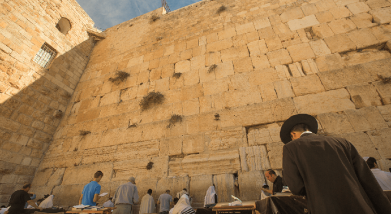 PMW 2024-029 by Kenneth L. Gentry, Jr., Th.D.
PMW 2024-029 by Kenneth L. Gentry, Jr., Th.D.
From time-to-time when I speak at conferences on the Olivet Discourse, I will have dispensationalists raise a question that they believe presents a problem for the preterist interpretation. I have even seen this in some published articles and books. Perhaps you have heard it yourselves. In fact, I know at least one of you have because you wrote me to ask me about it!
Now what is this challenge that some raise against the AD 70 fulfillment of the first portion of the Olivet Discourse? The challenge is:
How can you teach that AD 70 fulfills Jesus’ prophecy in Matthew 24:3? After all, that verse says “not one stone here shall be left upon another, which will not be torn down.” But we all know that the huge Wailing Wall that exists today was a part of the temple.
In reply I would note the following:
Foundation vs. Super-structure
First, the Wailing Wall is a portion of the retaining wall of the foundation of the temple, it is not a part of the temple building itself. The entire useable temple structure was demolished stone-by-stone. Josephus writes:
“Now as soon as the army had no more people to slay or to plunder, because there remained none to be the objects of their fury, (for they would not have spared any, had there remained any other work to be done,) Caesar gave orders that they should now demolish the entire city and temple, but should leave as many of the towers standing as were of the greatest eminency; that is, Phasaelus, and Hippicus, and Mariamne; and so much of the wall as enclosed the city on the west side. This wall was spared, in order to afford a camp for such as were to lie in garrison, as were the towers also spared, in order to demonstrate to posterity what kind of city it was, and how well fortified, which the Roman valor had subdued; but for all the rest of the wall, it was so thoroughly laid even with the ground by those that dug it up to the foundation, that there was left nothing to make those that came thither believe it had ever been inhabited. This was the end which Jerusalem came to by the madness of those that were for innovations; a city otherwise of great magnificence, and of mighty fame among all mankind” (J.W. 7:1:1).
Understanding the Olivet Discourse 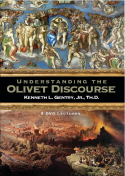
By Ken Gentry
This 5 DVD lecture set was filmed at a Bible Conference in Florida. It explains the entire Olivet Discourse in Matt. 24–25 from the (orthodox) preterist perspective. This lecture series begins by carefully analyzing Matt. 24:3, which establishes the two-part structure of the Discourse. It shows that the first section of the Discourse (Matt. 24:4–35) deals with the coming destruction of the temple and Jerusalem in AD 70. This important prophetic event is also theologically linked to the Final Judgment at the end of history, toward which AD 70 is a distant pointer.
For more educational materials: www. KennethGentry.com
Jesus prophesied while the temple stood and functioned. Before the Roman siege the temple was a magnificent structure that perfectly functioned as a temple for worship. In fact, Jesus’ prophecy is given just after he came out of the temple and was going away (Matt 24:1). After the siege the temple was a mass of rubble with only a few of its foundation stones remaining together. It was no longer magnificent; it was no longer suitable for worship. The “temple buildings” (Matt 24:1) were destroyed stone-by-stone.
Hyper-literalism
Second, to argue that this is a portion of the temple and that Matthew 24:2 has not yet been perfectly fulfilled and therefore still remains to be fulfilled is to demand a too literal interpretation. If we go that route, then we will have to dismiss numerous biblical prophecies that are not fulfilled in a pedantic manner and many biblical statements that are too generalistic.
For instance, in Acts 21:10–11 Luke writes: “And as we were staying there for some days, a certain prophet named Agabus came down from Judea. And coming to us, he took Paul’s belt and bound his own feet and hands, and said, ‘This is what the Holy Spirit says: “In this way the Jews at Jerusalem will bind the man who owns this belt and deliver him into the hands of the Gentiles.”’” Yet this prophecy did not come to pass in the exact manner presented.
We find this prophecy’s fulfillment in Acts 21:31, 33. But there it is not the Jews who physically bind him and deliver him to the Romans, but the Romans who seize him from the hands of the Jews who were attempting to kill him: “And while they were seeking to kill him, report came up to the commander of the Roman cohort that all Jerusalem was in confusion…. Then the commander came up and took hold of him, and ordered him to be bound with two chains.” Thus, it was not the Jews who literally “bind” Paul and then physically “deliver” Paul into the hands of the Gentiles. In fact, they were trying to kill him (Acts 21:31). He was rescued from the Jews, not delivered by them (Acts 21:32–25). Yet the fundamental, important point of Agabus prophecy is established: Paul went to Jerusalem and because of the Jews he ended up in jail by the Romans.
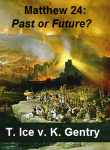
Matthew 24 Debate: Past or Future?
(DVD by Ken Gentry and Thomas Ice)
Two hour public debate between Ken Gentry and Thomas Ice on the Olivet Discourse.
See more study materials at: www.KennethGentry.com
Another example appears in Malachi 4:5: “Behold, I am going to send you Elijah the prophet before the coming of the great and terrible day of the Lord.” Despite this rather clear prophecy of “Elijah’s” return, Jesus clearly and dogmatically informs us of the non-Elijah fulfillment of the prophecy: “I say to you, that Elijah already came, and they did not recognize him…. Then the disciples understood that He had spoken to them about John the Baptist” (Matt. 17:11, 12). Yet the prophecy was fulfilled by someone coming in the spirit and power of Elijah.
Again were this pedantic hermeneutic employed, Peter could be faulted for an erroneous historical statement in Acts 1:18. There he stated that Judas purchased a field with the silver he received for betraying Christ. But Matthew 27:1–7 shows us that Judas was dead when the field was purchased by others. Yet the fundamental, relevant idea remains: the field was purchased with Judas’ payment for betraying Jesus.
Also what would we do with the several references that say the Jews crucified Christ? This is very much parallel to the situation presently before us. For instance, in Acts 3:13–14 we read:
“You disowned the Holy and Righteous One, and asked for a murderer to be granted to you, but put to death the Prince of life, the one whom God raised from the dead, a fact to which we are witnesses.” In Acts 5:30 Peter declares: “The God of our fathers raised up Jesus, whom you had put to death by hanging Him on a cross.”
These verses declare that the Jews “put to death” Jesus, even by “hanging Him on a cross.” Yet we know as a matter of historical record that the Romans were the ones who actually crucified Christ. John 19:13-16 is clear that Pilate “delivered Him up” to be crucified, for the Jews were not allowed the right to capital punishment (John 18:29–32). But the fundamental truth remains: the Jews cause Christ’s crucifixion.
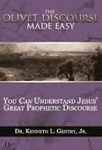
Olivet Discourse Made Easy (by Ken Gentry)
Verse-by-verse analysis of Christ’s teaching on Jerusalem’s destruction in Matt 24. Shows the great tribulation is past, having occurred in AD 70, and is distinct from the Second Advent at the end of history.
See more study materials at: www.KennethGentry.com
Christ as False Prophet
Third, to argue that this is some portion of the temple and that Matthew 24:2 has not yet been perfectly fulfilled and therefore still awaits fulfillment causes Christ himself to be a false prophet.
 The Truth about Salvation By Ken Gentry
The Truth about Salvation By Ken Gentry
A study guide for personal or small group Bible study. Deals with the Christian doctrine of salvation from a Reformed theological perspective. It opens with a study of God as loving Creator, the shows how the first man fell into sin. Shows God’s righteousness requires that sin be dealt with. Presents Jesus as both God and man so that he can be man’s Savior. Includes review questions and questions for further study.Twelve chapters are ideal for one quarter of Sunday School.
See more study materials at: www.KennethGentry.com
After all, the text states that the disciples pointed out the temple buildings to him, the very buildings from which he had just come (Matt 24:1). Then he says “to them” (those disciples who had just pointed to those temple buildings): “Do you not see all these things? Truly I say to you, not one stone here shall be left upon another, which will not be torn down” (Matt 24:2). They asked him “when will these things be” (Matt 24:3)? He informs them that a number of things must occur first (Matt 24:6, 8), but that finally: “this generation will not pass away until all these things take place” (Matt 24:34). Was Christ mistaken?
Get Your Facts Straight
Fourth, in the final analysis, if some hapless dispensationalism stumbles into your conversation on the Olivet Discourse and mutters this complaint (that some stones of the temple still remain, therefore the prophecy has not been fulfilled), direct him to go to any number of dispensationalist works that state that Matthew 24:2 was fulfilled in AD 70.
For instance, in Tim LaHaye’s Popular Encyclopedia of Bible Prophecy we read: “Clearly the [disciples] first question related to the destruction of the Temple, which happened during the Roman invasion and destruction of Jerusalem in A.D. 70” and “the disciples’ first question in the Olivet Discourse relates to the destruction of Jerusalem in A.D. 70” (p. 249). The Tim LaHaye Prophecy Study Bible states the same thing (p. 1151).
Then, if he will still not listen to you: Go to his house and take it apart stone-by-stone. If he complains you can respond: “But there are a couple of stones still connected, so nothing of the sort of thing you complain about really happened.”
The Divorce of Israel: A Redemptive-Historical Interpretation of Revelation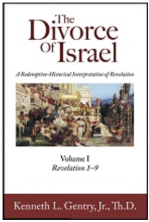
This long-awaited commentary is now at the printer and should be available for the public in late April, 2024. It is an 1800 page, two-volume deeply exegetical, academic commentary on the Bible’s most mysterious book.
Pre-order today for a special discount. Click: HERE
Kenneth L. Gentry Jr.'s Blog
- Kenneth L. Gentry Jr.'s profile
- 85 followers



